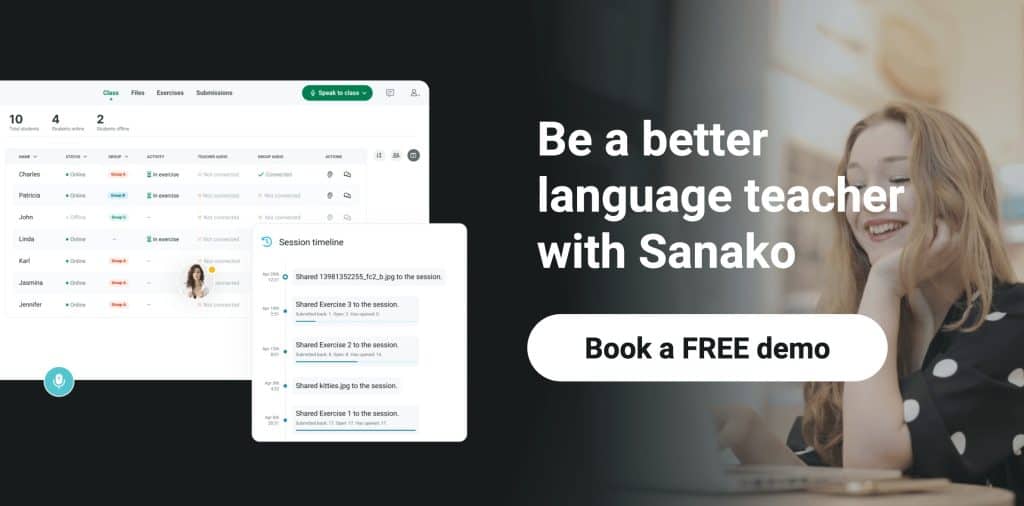One of the most significant themes to emerge in education during and after the Covid pandemic has been to recognise the importance of equal access to teaching and learning. Although usually focused on ensuring universal broadband and device provision, it’s also highly relevant for maintaining support to language students with educational challenges.
Importantly, whilst educators are ultimately responsible for the progress of these students, many teachers worry that they are not providing effective support for students with special educational needs (SEN) in the classroom (Warnes et al., 2021). This blog post therefore looks at how educators and institutions can best support SEN students to succeed in their language learning.
Language learners and SEN
It’s worth emphasising from the outset that the opportunity to learn a new, foreign language should be equally available to all students. Indeed, language learning delivers significant benefits to ALL students but offers unique benefits to students with SEN.
Writing on Special Educational Needs, David Wilson sums this up perfectly: ”Like their non-SEN peers, students with SEN will only reach their full potential if they are given the opportunity to move outside their comfort zone and to learn new skills.”
For all learners, language lessons do exactly that. They challenge students to move beyond the conventional and the everyday; to immerse themselves in new cultures and new environments; to use new expressions and words, whilst developing and improving a range of academic and life skills. This is increasingly important for students with SEN, or families with children who are SEN, as improved medical care and greater mobility mean that international travel is more accessible and available.
Furthermore the study of a new international language can also help all pupils to better appreciate and understand diversity. Not only does this help SEN students to feel less isolated and separate from their peers, it also helps their peers to feel a little of what SEN students might be going through.
Be proactive
Clearly language learners with SEN can experience a variety of academic and social challenges that negatively impact their ability to succeed and reach their potential. It is vital therefore that educators take a proactive approach to addressing and reducing these barriers – if this does not happen, challenging and disruptive behaviours can then occur.
It is also important to note that a student’s specific needs may change throughout their learning journey. Some students may be facing a permanent issue (typically as a result of a medical condition), but others may change over time. Particularly as a result of a successful intervention by an educator or institution.
Continually monitoring students and working with guardians and relevant key workers is therefore key to keeping on top of your students’ needs. Tailoring your practice and environment to their needs remains the most effective way to support SEN students and to reduce barriers to learning.
Tailoring your practice
There is clear evidence that the best language classes lend themselves to SEN-friendly teaching strategies. The use of repetition to reinforce learning and adopting a multisensory approach (e.g through the use of music and singing) along with using flashcards can all be highly effective ways to improve students’ memory and boost their confidence.
Writing for the UK’s Association for Language Learning, David Wilson identifies a wide variety of other ways to engage and support SEN students in their language learning. He highlights:
- presenting subject matter in a structured and explicit manner;
- dividing lessons into digestible “bite-size chunks” with slower learning steps;
- providing opportunities for “over-learning” key points through a variety of follow-up activities;
- deploying memory strategies to assist vocabulary and grammar retention;
- making allowances for shorter concentration spans;
- encouraging metacognitive – “learning how to learn” – strategies and thinking skills to promote student autonomy;
Wilson also reiterates the importance of actively engaging SEN students in lessons, whilst being sympathetic to their ability to articulate or provide a response. The role of praise and rewards to keep motivation and self-esteem at high levels is also important. And it all helps to boost students’ confidence, engagement, enjoyment and chance of success!
It’s also important for educators when planning lessons to ensure that their lesson objectives are appropriately differentiated for all learners but remain ambitious in their scope. Do also consider how educational technology can be used to scaffold learning as well as to provide personalised questions / support as well as prompt feedback.
Whilst on feedback, it’s important to ensure that SEN students are fully incorporated into their classes and that they have the chance to engage with and learn from their peers. This is particularly important when planning conversation practice – talk partners play a key role in supporting SEN students in building their confidence and giving them the opportunity to practice and rehearse their conversations / responses.
Creating an inclusive classroom
As well as adapting teaching practice, it’s also important that SEN students can enjoy learning in a collaborative, positive and supportive environment. Take time to ensure that the learning ethos is crystal clear and underpinned by a consistent and positive approach to behaviour. The below list of 4 tips expand the key ideas addressed in our previous article “Learning disabilities and foreign language learning”:
1. Understand each pupil and their needs
It is imperative to understand the particular needs of each child, so that effective and personalised interventions can be put in place to support them. The most important source for this information is the child or young person themselves, so consult them regularly and involve them in decision-making. Other people who know and engage with them – parents, carers and other professionals – can also be useful sources of information.
A class feelings board can be a good way for all students to consider and express their emotions in a visual way. It also provides an indication to the adults working with them of their emotions, which can enable educators to adapt their approach and practice.
2. Careful communication
Adapting and tailoring your communication (spoken, verbal and non-verbal) can be hugely important in supporting students with educational difficulties. Top tips include keep your guidance clear and concise; only issue instructions one at a time; combine verbal instructions with visual aids; avoid idiomatic language and where possible, get students to repeat the instructions back to you to check for understanding.
3. Classroom organisation
Ensuring that the language learning space is appropriately organised can be a huge benefit to students and maximise their chances of success. Consider reducing classroom displays to focus attention on classroom organisation and lesson instruction; use a visual timetable and take care to choose appropriate colours in all documents and presentations. The provision of key resources and materials (e.g. writing slopes, pen / pencil grips, wobble cushions etc.) can all also be hugely helpful.
4. Technology support
There’s also an important role for technology to play in supporting learning and those students who need extra help. Technology-based language lessons serve to broaden access to learning and help widen students’ horizons beyond their home or local environment. They also serve to develop valuable ICT skills that can eventually enhance student’s lives and employment prospects when they leave education.
Whatever language you teach and whatever educational difficulties your students might be facing, Sanako’s market-leading tools are here to help. We’re constantly innovating to create technology that enables language educators to teach languages more efficiently and more successfully. It’s why the world’s leading educational institutions choose Sanako as their preferred supplier to support online and in-person lesson delivery.
If you’d like to find out how Sanako Connect could help you develop your students’ core language skills across the full range of global languages, click here or the banner below to learn more!

